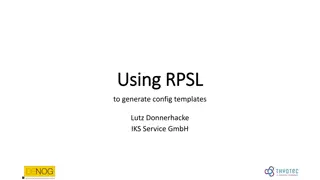Enhancing Security Measures at Internet Exchange Points (IXPs)
Exploring the need to improve peering LAN security at IXPs to mitigate risks such as unwanted traffic processing, routing security vulnerabilities, and injection of harmful routes. Discussing the evolution of standards, filtering capabilities, and data analysis to enhance security protocols.
Download Presentation

Please find below an Image/Link to download the presentation.
The content on the website is provided AS IS for your information and personal use only. It may not be sold, licensed, or shared on other websites without obtaining consent from the author.If you encounter any issues during the download, it is possible that the publisher has removed the file from their server.
You are allowed to download the files provided on this website for personal or commercial use, subject to the condition that they are used lawfully. All files are the property of their respective owners.
The content on the website is provided AS IS for your information and personal use only. It may not be sold, licensed, or shared on other websites without obtaining consent from the author.
E N D
Presentation Transcript
Peering LAN Security at IXPs Revisited Greg Hankins, Nokia Daniel Kopp, DE-CIX Matthias Wichtlhuber, DE-CIX GPF 2024 April 15, 2024
Background and Motivation IXPs want to make peering LANs as secure as possible to only forward wanted traffic A lot of work has been done to define BCPs, RFCs and other standards several years ago, but they have not evolved with peering traffic changes Especially with IPv6 adoption and traffic growth Router hardware technology and protocols have also evolved Layer 3 filtering capabilities EVPN We looked at what types of Layer 2 and Layer 3 traffic is seen on a large IXP peering LAN Can we make peering LANs more secure now?
BCPs and Standards Several BCPs and standards have been written on IXP port hygiene and peering LAN security MANRS, Open-IX, Euro-IX, etc. IXP service definitions and configuration guides RFC 5963, RFC 7113 Some are more detailed than others, but none cover everything in one place A lot of specific filtering details are missing and must be figured out by each IXP and customer Where should these documents and examples be maintained? Who should maintain them? Standards: https://xkcd.com/927/
What are the risks to IXP customers? Noise Unwanted traffic that the customer router processes and drops in hardware or software Routing security risk that are accidental or malicious Injecting routes to customers will cause bad things to happen For example, form an OSPF adjacency Many good examples were presented by Mike Jagarat APRICOT 2010 in Monkeying around on the APE (https://conference.apnic.net/29/pdf/IXPs_02_Monkeying-around-on-the- APE_Mike-Jager.pdf) There is little risk to the IXP switch or router because customer traffic is forwarded transparently at Layer 2 What do you think IXPs should filter? Is this a problem from an IXP customer perspective?
Data Sources We looked at two sources of data on the DE-CIX peering LANs Layer 2 filters as seen by the IXP and a customer Layer 3 filters as seen by a customer Analyzed data plane and control plane traffic looking for Frame types that should be filtered, like LACP, Layer 2 discovery protocols and MPLS Protocols and link-local packets that should be filtered, like Layer 3 discovery and routing protocols
Layer 2 Security and Analysis Layer 2 peering LAN security is needed for two important functions Forward wanted EtherTypes and drop all others Forward ARP Forward IPv4 Forward IPv6 Drop everything else Prevent Layer 2 loops that are accidentally introduced by customers Allow one MAC address, one IP address per port Drop router source MAC on egress Drop router destination MAC on ingress IXP
Layer 2 Security and Analysis IXP Filter Drop Counters A small percentage of unwanted traffic is dropped by IXP filters Ingress Filter counter total: 0.00001410616238% Total bytes: 0.00000154405386% Egress Filter counter total : 0.05181140812% Total bytes: 0.01734255394%
Layer 2 Security and Analysis Conclusion Defined well in BCPs and standards Clear on what frames should be forwarded or dropped Also provides IPv4 Layer 3 control plane protocol filtering based on EtherTypes [/] A:user@customer-router# show system security cpm-filter ip-filter =============================================================================== CPM IPv6 Filter (applied) =============================================================================== Id Dropped Forwarded Description ------------------------------------------------------------------------------- 1088 0 0 EIGRP 1089 0 0 OSPF 1103 0 0 PIM 1112 0 0 VRRP 1124 0 0 IS-IS Working as implemented on the DE-CIX peering LANs to forward wanted frames We expect this is also working well at other IXPs
Layer 3 Security and Analysis Layer 3 peering LAN security is needed to drop unwanted discovery and routing protocols Link-layer protocols should be filtered, but the BCPs and standards are either vague or don t mention them at all Easy for IPv4 because EtherTypesfiltering works for Layer 2 and Layer 3 protocols Harder for IPv6 because you need to filter on multicast addresses and/or the IPv6 Next Header for each protocol What about Layer 3 protocols like DHCP that can be routed (relayed)? Restrict filtering to traffic sent to the peering LAN IP prefix
Layer 3 Security and Analysis Filter Counters [/] A:user@customer-router# show system security cpm-filter ipv6-filter =============================================================================== CPM IPv6 Filter (applied) =============================================================================== Id Dropped Forwarded Description ------------------------------------------------------------------------------- 5 0 21230 ICMPv6 Router Solicitation 10 0 11606028 ICMPv6 Router Advertisement 15 0 31372486341 ICMPv6 Neighbor Solicitation 20 0 54029357 ICMPv6 Neighbor Advertisement 25 0 0 ICMPv6 Redirect 30 0 30570679 ICMPv6 Echo Request 35 173897 0 ICMPv6 MLDv1 Query 40 776050 0 ICMPv6 MLDv1 Report 45 111814489 0 ICMPv6 MLDv2 Report 50 10 0 ICMPv6 MLDv1 Done 55 0 1054 ICMPv6 Time Exceeded 60 0 36273 ICMPv6 Destination Unreachable
Layer 3 Security and Analysis Unwanted IPv6 Protocols Top unwanted protocols matched by Layer 3 filters Omitted No IPv6 Next Header ICMPv6 Redirect Other ICMPv6, needs more detailed packet analysis Noise (small risk): MLD, other ICMPv6 Routing security risk: RA/RS, OSPFv3, PIMv6 67.724% 16.728% 10.581% 3.250%1.429%0.278% 0.008% 0.001%
Layer 3 Security and Analysis Filtering Filtering configurations must drop specific packet types and/or multicast addresses and permit everything else These filters must be updated as technology evolves Modern routers have more advanced filtering capabilities in hardware Some IPv6 link-local protocols must be filtered on the Next Header Should IXPs permit specific Layer 3 packet types and drop everything else instead?
Layer 3 Security and Analysis Conclusion Not defined well in BCPs and standards Unclear on what packets should be forwarded or dropped Getting it right is difficult and requires a lot more filter entries Risk of accidentally dropping legitimate traffic This may be an issue on peering LANs depending on how Layer 3 IPv6 filters are implemented
Technology evolutions make Peering LANs More Secure EVPN Neighbor discovery (IPv4 ARP, IPv6 ND) starts to become a problem as peering LANs get bigger Generates lots of control plane traffic of up to several thousand packets per second that must be processed by all routers on the peering LAN Even though the routers may not be exchanging traffic New technology like EVPN reduces neighbor discovery traffic significantly Replies are proxied from the IXP s router based on a static database of MAC addresses Broadcasts are limited by the IXP s router
Technology evolutions make Peering LANs More Secure EVPN /22 to /21 EVPN! ARP traffic on the DE-CIX Frankfurt peering LAN 2015 to 2023
Conclusions and Next Steps Router hardware Layer 3 filtering and software technology like EVPN has evolved Gives IXP operators many new tools to make the peering LAN more secure A lot more needs to be done to make IXP peering LANs more secure Layer 2 peering LAN security is working, Layer 3 needs to be revisited We suspect this may be an issue in the IXP community as well We need more investigation and action in the IXP community
Conclusions and Actions BCPs, standards and configuration examples need to be updated IPv6 protocols and Next Header filtering (ND, MLD, OSPF, PIM, etc.) New technology like EVPN to reduce BUM traffic IXPs should examine their quarantine procedures and filtering Router configurations change after quarantine, so implement good filters IXP participants should look at their router filtering You decide what traffic you accept, don t only rely on the IXP to filter Also consider filtering on private peering links
Questions? Comments? Thoughts?























